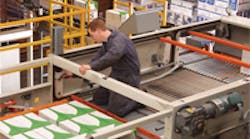A comprehensive machine assessment will list modifications that can enhance performance.
Getting the most out of your machinery—both in t ime and performance— doesn’t happen by accident. It requires attention. Equipment might be built to withstand the environs of a shop floor, but it also requires regular care.
Preventive maintenance can go a long way toward ensuring healthy, and long-lasting, machinery. Systematic inspection can detect many problems before they occur. But, even preventive maintenance isn’t infallible.
It is for this reason that machine and systems manufacturer FKI Logistex, which recently was purchased by Intelligrated, is offering “palletizer audits.” Designed to help FKI Logistex customers restore their palletizers to original operating performance and to identify any potential upgrades, the audits may help to optimize the equipment and extend its life by years.
Performed by certified audit engineers, trained in palletizer maintenance and OEM specifications, the audits include a review of operating and maintenance practices and a thorough, infeed-to-discharge inspection of all palletizer components. Every potential wear point is examined, including chains, rollers, and other moving parts. Upon completion of the inspection, the audit engineer prepares a detailed formal report— ranging from as short as 15 pages, to as long as 75— that documents the audit findings and outlines a recommended course of action.
“One of the biggest misconceptions I find among customers is that having a preventive maintenance program means you’re identifying all the potential problems on a machine,” says Ken Morris, manager of customer service and support audits at FKI Logistex. “Doing these little repairs or lubing the chains or tightening a few screws just doesn’t get deep enough into the wear and tear that happens. There’s a lot of stuff that they miss that we can catch.”
For example, Morris cites shaft wear inside a gear reducer. Normally not an area inspected in most preventive maintenance check-lists, Morris warns that if left alone, shaft-wear can lead to a breakdown.
The audit report includes a comprehensive machine assessment that specifies items requiring cleaning, adjustment, lubrication, repair, or replacement to restore the palletizer to optimum performance. A comprehensive list of recommended modifications, upgrades, preventive maintenance techniques, and spare parts is provided. The report also includes equipment drawings, performance checklists, and a portfolio of digital photos for technical reference.
While palletizer audits have always been essential, Morris says the need has only grown as economic conditions have worsened and maintenance departments have been reduced. “Most companies I’ve been to, across the board, have fewer guys available to do a detailed inspection of their equipment,” says Morris. “And, the people doing it might not be as well trained or equipped. With the way things are now, capital resources are minimal, so companies have got to keep that equipment running and maximize their up-time.”
A palletizer audit costs $500 per machine, plus living and travel expenses for the on-site engineer. For a sortation system, it’s $1,100 for a weekday and $1,500 for a weekend visit, along with whatever living and travel expenses.
That cost, when added to the bill for replacing pieces or sections of a machine, could make many companies wince. But it’s the difference between being penny wise or pound foolish.
“Consider what the cost is when there’s downtime for a major production line,” says Morris. “Or consider the cost of an unanticipated breakage, when a part goes and you have to send out for a replacement. The cost for an audit? It’s a pittance to the alternative.”






